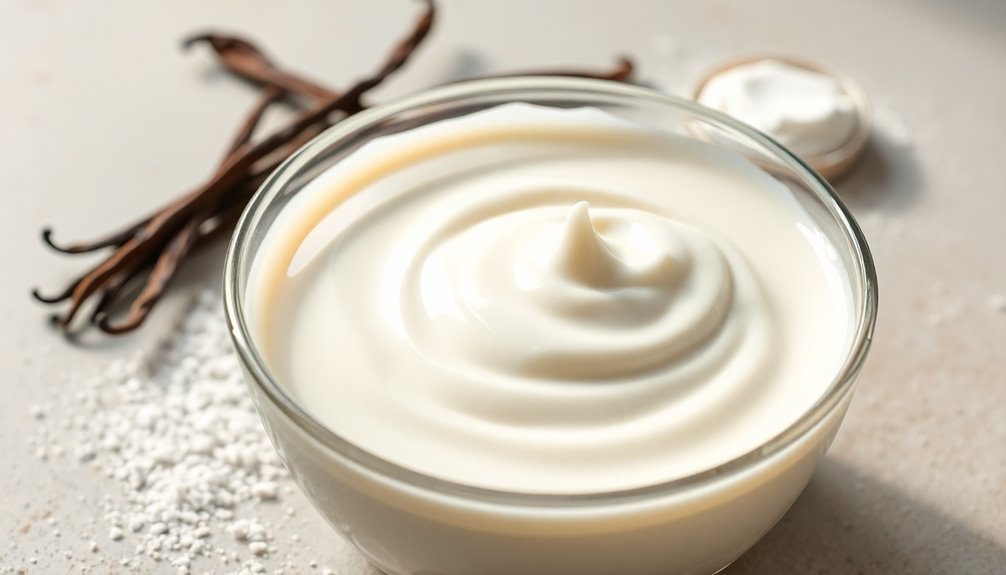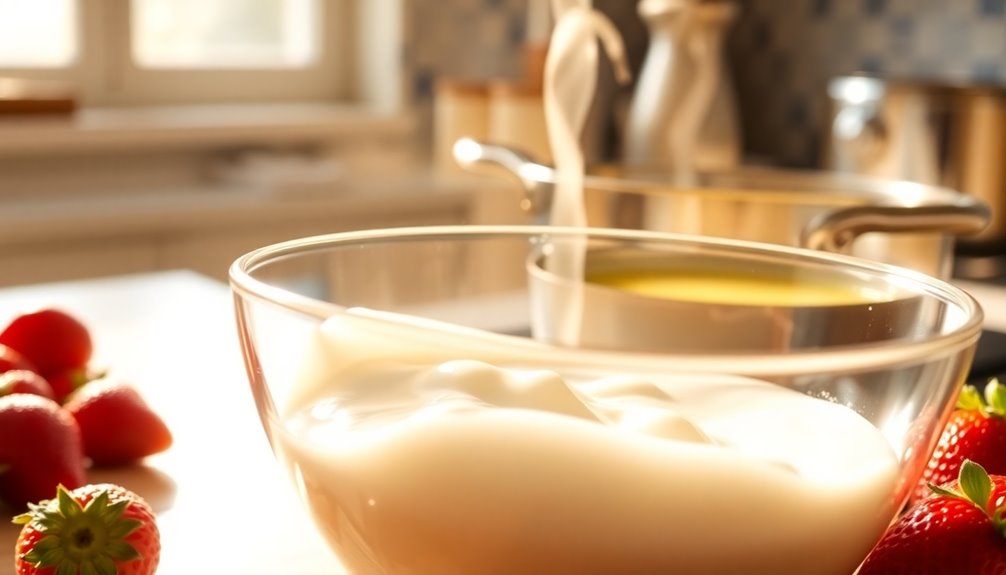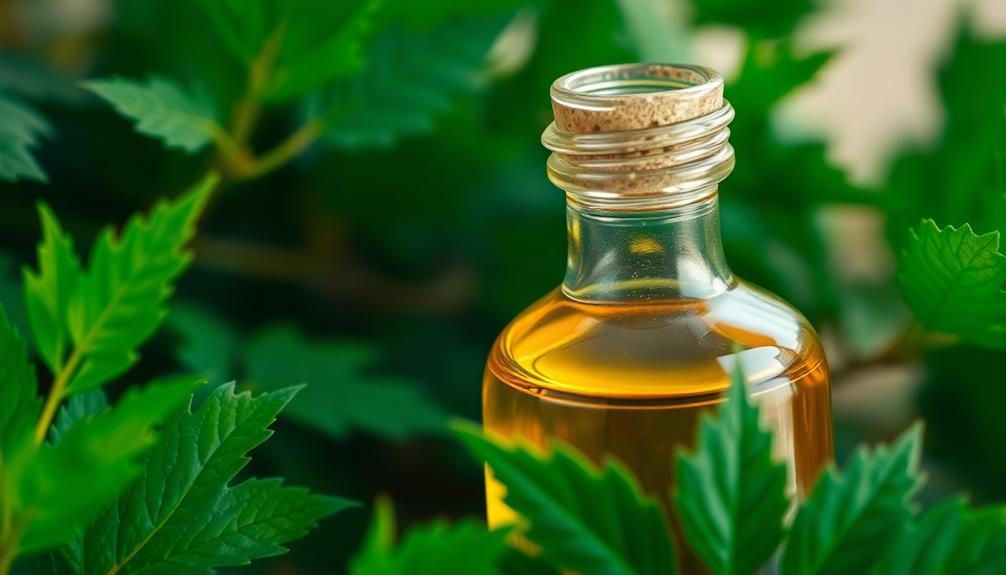Fresh heavy cream has a mild and sweet aroma that's rich and creamy. You might detect subtle hints of vanilla or marshmallow, reminiscent of fresh milk. It's a pleasant scent that enhances dishes when cooking. However, if the cream starts to smell sour or off, it's a sign of spoilage, indicating you should discard it. Oxidation can also cause odd odors, even in fresh cream. Different brands or storage methods may slightly change the scent. You'll find it fascinating to explore how these factors influence the aroma and quality of heavy cream further.
Key Takeaways
- Fresh heavy cream has a mild, rich aroma with hints of sweetness and notes of fresh milk or vanilla.
- Spoiled cream emits a strong, sour smell resembling curdled dairy, indicating it's no longer safe to use.
- Oxidation can cause fresh cream to develop unpleasant, metallic odors, affecting its scent profile.
- The smell of heavy cream can vary based on brand, processing methods, and storage conditions.
- Assessing the aroma is crucial for safety; discard cream with any off or strong sour smells.
Introduction

When you think about heavy cream, you might picture its rich, creamy texture, but its scent also plays a crucial role in how you experience this dairy product. Heavy cream typically smells a bit sweet and dairy-like, reminiscent of fresh milk or butter. When it's fresh, you'll notice a subtle, pleasant aroma that enhances its appeal without any strong or off-putting odors.
However, the scent profile can change drastically if the cream spoils. Spoiled heavy cream emits a sour smell, often likened to cheese or rancid dairy, which is definitely not what you want in your cooking or baking. Additionally, exposure to air can lead to oxidation, which might cause even fresh cream to develop unusual smells.
Keep in mind that the scent can vary slightly depending on the brand, processing methods, and storage conditions of the cream. So, when you open a carton of heavy cream, take a moment to appreciate its aroma. It's not just about taste; the smell can significantly influence your culinary experience, making it essential to recognize both fresh and spoiled scents.
Description of the Smell

The smell of heavy cream is a delightful experience that can enhance your culinary endeavors. When you first open a carton of fresh cream, you'll notice its mild, rich aroma, which is slightly sweet and creamy, characteristic of its high-fat content. This scent often evokes hints of fresh milk, along with a touch of sweetness reminiscent of vanilla or marshmallow.
However, it's essential to pay attention to the smell, as it can indicate the quality of your heavy cream. If the cream has gone bad, you might detect a sour or off scent, resembling cheese or even a metallic odor due to fermentation. This change in aroma is a clear sign that it's time to discard it.
Additionally, exposure to air can lead to oxidation, causing the cream to emit unusual or unpleasant smells even if it doesn't appear spoiled. You may also notice slight variations in the scent profile depending on the brand and processing method, with some brands offering a thicker and more pronounced dairy aroma. Always trust your nose when assessing the freshness of your heavy cream!
Source and Composition

Heavy cream comes from the top layer of milk, where the rich, high-fat content separates naturally. Specifically, it contains 36-40% milk fat, making it a luxurious addition to various dishes. When you think about the composition of heavy cream, you'll find that it consists of proteins, lipids, and carbohydrates, which all contribute to its creamy texture and indulgent fragrance.
The smell of heavy cream is typically mild and creamy, with a slight sweetness that can remind you of butter or a lactonic quality. When it's fresh, you'll notice a clean, pleasant odor. However, if you detect any sour or off smells, it's a sign that the cream has gone bad.
Processing methods, like pasteurization and homogenization, can slightly alter the aroma of heavy cream. These changes can affect your perception of its freshness and overall smell. So, when you're working with heavy cream, pay attention to its composition and scent, as they're key indicators of its quality and flavor potential.
Typical Scenarios or Environments

In various kitchens and dining settings, you'll encounter heavy cream in different ways that influence its aroma. Fresh heavy cream typically boasts a mild, pleasant dairy smell, reminiscent of fresh milk. This subtle sweetness fills the air as you whip it for a rich dessert or blend it into a sauce. However, as the heavy cream nears its expiration date, you might notice a shift in its scent. If it develops a sour odor, it could indicate spoilage, similar to the sharp smell of sour cream that's gone bad.
Cooking with heavy cream can also change its aroma. Heating it intensifies that rich, creamy fragrance, elevating savory dishes like soups and sauces. But beware: if you leave heavy cream exposed to air, it can oxidize, leading to off smells that resemble metallic or unpleasant scents. In cases of spoilage, the strong, sour smell can remind you of cheese or curdled dairy, signaling it's time to discard it. Thus, understanding these typical scenarios helps you appreciate the delightful aroma of heavy cream while being mindful of its freshness.
Emotional or Cultural Associations

Often, the aroma of heavy cream stirs up strong feelings of comfort and nostalgia. You might find yourself recalling family gatherings, where rich desserts and home-baked goods took center stage. The scent of heavy cream is often linked to indulgence and luxury, making it a staple in festive dishes that symbolize abundance. When you smell that sweet, lactonic aroma, it can trigger delightful memories of childhood treats, like whipped cream adorning your favorite desserts or creamy sauces that warmed your heart.
In various cultures, heavy cream plays a vital role in culinary traditions, from French sauces to Italian gelato, connecting its scent to regional pride and heritage. You may feel a sense of warmth and security as you think of these cultural dishes, enriching your dining experiences. The aroma of this dairy product also sparks creativity in the kitchen, inspiring both chefs and home cooks to experiment with new recipes and flavor combinations. So, the next time you catch a whiff of heavy cream, embrace the memories and cultural significance it brings to your life and the lives of those around you.
Health or Safety Considerations

When considering the freshness of heavy cream, it's crucial to pay attention to its scent. Ideally, heavy cream should have a fresh, mild dairy aroma. If you detect a strong sour or unpleasant odor, it's a clear sign that the cream has likely spoiled, and you shouldn't use it. The shelf life of heavy cream is typically around 21 days, so if it's been longer than that, be extra cautious.
A slightly sour smell can indicate that the cream has passed its expiration date, making it unsuitable for consumption. Always check for visible signs of spoilage, such as curdling, lumps, or separation, as these often accompany off odors. If you notice any abnormalities, don't hesitate to discard the cream.
Consuming slightly off heavy cream can pose a risk of foodborne illness, particularly if it has developed strong odors or unusual textures. To ensure your safety, always assess the aroma before use. If you're unsure, it's better to err on the side of caution and avoid using it altogether. Trust your senses to tell if heavy cream is still safe for consumption.
Final Thoughts

Evaluating the smell of heavy cream is essential for ensuring its quality and safety in your kitchen. When fresh, heavy cream offers a rich, mildly sweet aroma that reminds you of fresh milk and butter. As you use heavy cream, it's crucial to be aware of its life. If it's been days past the sell-by date, the smell may change, indicating spoilage. A strong sour or off-putting odor signals that it's time to discard it.
Proper storage plays a significant role in maintaining the best quality. Keep it tightly sealed in the fridge, as exposure to air can lead to oxidation, resulting in unpleasant odors. Remember, the smell can become more pronounced as it ages, often resembling cheese or sour dairy. This sensory evaluation helps you determine freshness before using it in recipes.
Frequently Asked Questions
Is Heavy Cream Supposed to Smell?
Yes, heavy cream is supposed to smell, but it should have a mild, sweet, and creamy aroma. When you open a carton of fresh heavy cream, you should notice a subtle dairy scent. If you detect any strong or sour odors, that's a sign it's gone bad. Always trust your nose; if it smells off, it's best to discard it. Fresh heavy cream enhances your recipes with its delightful fragrance.
How Do You Know if Heavy Cream Has Gone Bad?
To know if heavy cream's gone bad, you should trust your senses. Check for a strong sour smell or any cheese-like odor; that's a red flag. Look for lumps or curdling, and be wary of a yellowish-green tint. If it tastes off or metallic, it's best to toss it. Always remember to check the expiration date, as heavy cream typically stays fresh for about 2-3 weeks once opened if stored properly.
What Does Heavy Cream Body Mist Smell Like?
When you try Heavy Cream Body Mist, you'll immediately notice its delightful, gourmand scent. The top notes of marshmallow and citrus invite you in, while the middle notes of coconut and jasmine add a warm, sweet touch. As it settles, the base notes of whipped cream, vanilla, and caramel create a rich, comforting aroma that feels like a decadent dessert. It's perfect for those who love a cozy, inviting fragrance!
How Can You Tell if It's Heavy Cream?
To tell if it's heavy cream, look for a smooth, thick texture. It should feel velvety when you pour it. Give it a sniff—fresh heavy cream has a light, sweet dairy scent. If you notice any sour or rancid odors, it's best to discard it. Also, check for clumping or curdling; these signs indicate spoilage. Always trust your senses to ensure you're using fresh, quality cream in your recipes.









